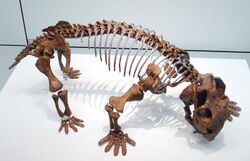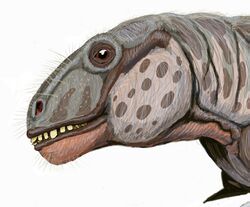Biology:Anomodont
| Anomodonts | |
|---|---|

| |
| Mounted skeleton of Lystrosaurus | |
| Scientific classification | |
| Domain: | Eukaryota |
| Kingdom: | Animalia |
| Phylum: | Chordata |
| Clade: | Synapsida |
| Clade: | Therapsida |
| Suborder: | †Anomodontia Owen, 1859 |
| Subgroups | |




Anomodontia is an extinct group of non-mammalian therapsids from the Permian and Triassic periods.[1] By far the most speciose group are the dicynodonts, a clade of beaked, tusked herbivores.[2] Anomodonts were very diverse during the Middle Permian, including primitive forms like Anomocephalus and Patranomodon and groups like Venyukovioidea and Dromasauria. Dicynodonts became the most successful and abundant of all herbivores in the Late Permian, filling ecological niches ranging from large browsers down to small burrowers. Few dicynodont families survived the Permian–Triassic extinction event, but one lineage (Kannemeyeriiformes) evolved into large, stocky forms that became dominant terrestrial herbivores right until the Late Triassic, when changing conditions caused them to decline, finally going extinct during the Triassic–Jurassic extinction event.
Classification
Taxonomy
- Order Therapsida
- Suborder Anomodontia
- Biseridens
- Patranomodon
- Clade Anomocephaloidea
- Infraorder Venyukovioidea
- Clade Chainosauria
- ?Galechirus
- Galeops
- Galepus
- Infraorder Dicynodontia
Phylogeny
Cladogram modified from Cisneros et al., 2015.[3]
| Anomodontia |
| |||||||||||||||||||||||||||||||||||||||||||||||||||
Cladogram modified from Angielczyk and Kammerer (2017):[4]
| Anomodontia |
| ||||||||||||||||||||||||||||||||||||||||||||||||||||||||||||
See also
References
- ↑ Liu, J.; Rubidge, B.; Li, J. (2009). "A new specimen of Biseridens qilianicus indicates its phylogenetic position as the most basal anomodont". Proceedings of the Royal Society B 277 (1679): 285–292. doi:10.1098/rspb.2009.0883. PMID 19640887.
- ↑ Chinsamy-Turan, A. (2011) Forerunners of Mammals: Radiation - Histology - Biology, p.39. Indiana University Press, ISBN:0253356970. Retrieved May 2012
- ↑ Cisneros, Juan Carlos; Abdala, Fernando; Jashashvili, Tea; De Oliveira Bueno, Ana; Dentzien-Dias, Paula (2015). "Tiarajudens eccentricus and Anomocephalus africanus , two bizarre anomodonts (Synapsida, Therapsida) with dental occlusion from the Permian of Gondwana". Royal Society Open Science 2 (7): 150090. doi:10.1098/rsos.150090. PMID 26587266. Bibcode: 2015RSOS....250090C.
- ↑ Angielczyk, Kenneth D.; Kammerer, Christian F. (2017). "The cranial morphology, phylogenetic position and biogeography of the upper Permian dicynodont Compsodon helmoedi van Hoepen (Therapsida, Anomodontia)". Papers in Palaeontology 3 (4): 513–545. doi:10.1002/spp2.1087.
Wikidata ☰ Q131803 entry
 |

